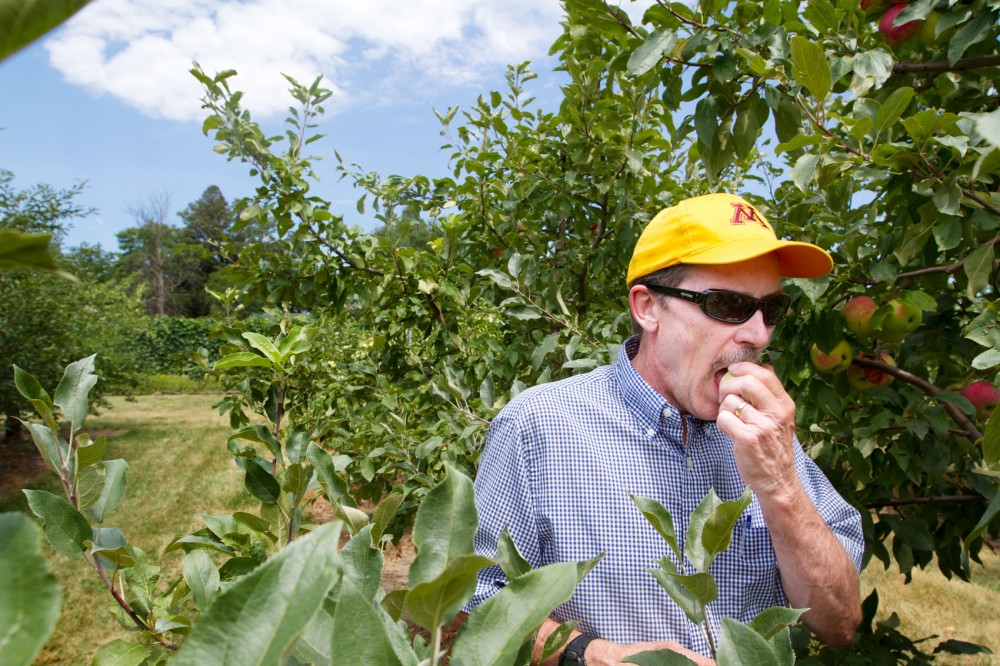Genetically modified apples can’t be found at a grocery store in the United States, but a Canadian company could change that.
Okanagan Specialty Fruits, a company based in British Columbia, has developed a genetically modified apple it claims does not turn brown when cut. The company is trying to get approval from the U.S. Department of Agriculture to market its Arctic Apple to consumers, prompting debate in the U.S. apple industry. ian company could change that.
David Bedford, a scientist with the University of Minnesota’s apple breeding program, said he thinks it will take modifying a trait more important than browning to change the views of the apple industry and the American public, which currently do not favor genetically modifying apples.
The U.S. Apple Association said in a statement they do not want the USDA to allow Okanagan to plant their apples in the United States.
“Ultimately, the future of [genetically modified] apples in the United States will be determined by USDA’s decision on the two petitions and by the marketplace” the association said in the statement. “The market will have time to decide, since new apple trees take years to come into production.”
Crops can be genetically modified to have favorable characteristics like resistance to certain diseases or pests. Plants are usually genetically modified by adding genes to the plant’s genome that will produce the change. It can take decades to introduce this kind of change naturally though selective breeding.
Genetic modification in the United States is highly controversial. But Bedford said that is mainly because people don’t know enough about it.
“There are some legitimate questions,” Bedford said, “and then there’s a certain amount of just hysteria from not understanding.”
According to a 2010 survey by Thomson Reuters, 64 percent of Americans said they were unsure of whether genetically modified foods were safe.
The University’s program has already developed an apple called SnowSweet “the natural way” — without genetic modification — that is also very slow to brown when cut.
They breed apples by crossing one tree with another to develop new varieties. But this can take a lot longer than genetically modifying them.
Bedford said the shortest amount of time the University has taken to breed a new type of apple was 19 years.
Jim Luby, professor of horticultural science, said breeding SnowSweet to be slow browning was an accident.
“It was not something we were necessarily looking for from that cross,” he said. “But it was one of those serendipitous kinds of things that happen in science sometimes.”
The apple breeding process
In the apple breeding program’s 134-year history, only 26 apple varieties have been named and released from the University.
In the spring, apple breeders go out and cover up the flowers before they open. Once the flowers open, they take the bags off and collect the pollen in a petri dish. Then, they apply the pollen to another tree’s flowers with their fingers, which then breeds a tree with a known parentage.
When the trees bear fruit 5 to 8 years later, Bedford tastes a few apples from every tree and rates them on 20 different traits ranging from disease heartiness to flesh color, with the most important being texture and flavor. With 3,000 to 5,000 apple-bearing trees every year, Bedford, said he tastes between 500 and 600 apples per day and has been doing so for 32 years.
“I wish I could tell you we have a robot that goes through and detects the good apples, but the fact is I’m the robot,” he said. “I have to eat them all.”
Bedford said only 10 to 15 trees per year move on to further testing, and the rest get thrown away. Part of the reason they are so harsh, he said, is to make sure the apples the University releases are of the consistent quality growers rely upon.
The GMO debate
With genetic modification, researchers know what they will get when they alter a gene.
Bedford said he thought genetic modification could be useful because it could speed up the process of developing new apple varieties but that it should be well-regulated.
Sehrish Javaid is a graduate student who said she has extensively studied cancer epidemiology. She said she thinks the genetic modification of food is behind many new diseases.
“There is always a problem when people interfere with nature,” she said.
Myisha Poindexter, a pre-med senior, said she would definitely buy Okanagan’s genetically modified apple — as long as it was inexpensive — because she always looks for apples without bruises.
“I’m just not someone who tends to look into these kinds of factors when it comes to eating something,” she said, “because a lot of things that are in the store tend to be genetically modified.”
It is true that 93 percent of soybeans and 26 percent of corn in the U.S. are genetically modified.
But apples would be the fourth fruit with genetic modification in the U.S. market after papayas, tomatoes and plums, according to the USDA.
Another student, Ben Goggin, said he was more hesitant and felt unsure about genetically modified foods because he has not seen that much research on them.
He said for now, he would probably buy Okanagan’s apple but that it could negatively affect the food industry and economy.
“It’s kind of scary buying genetically modified food,” he said, “because I don’t exactly know if it would affect my health.”


